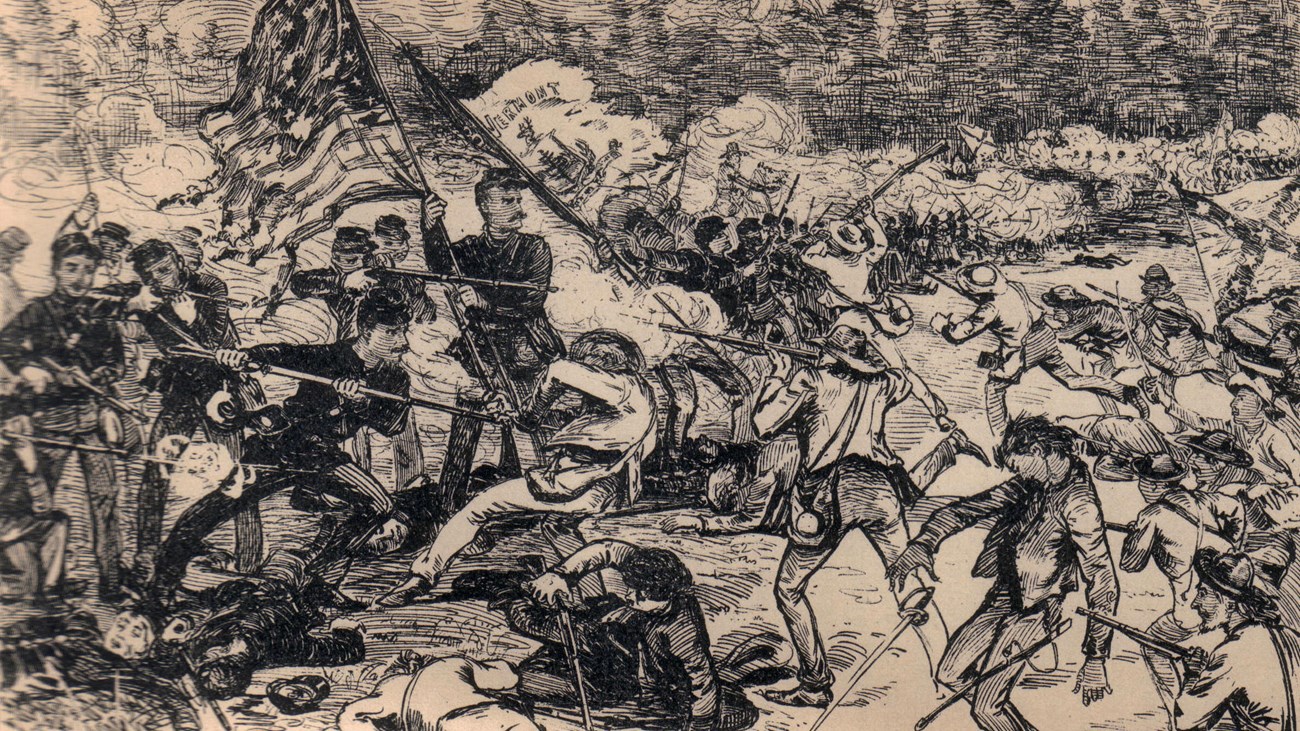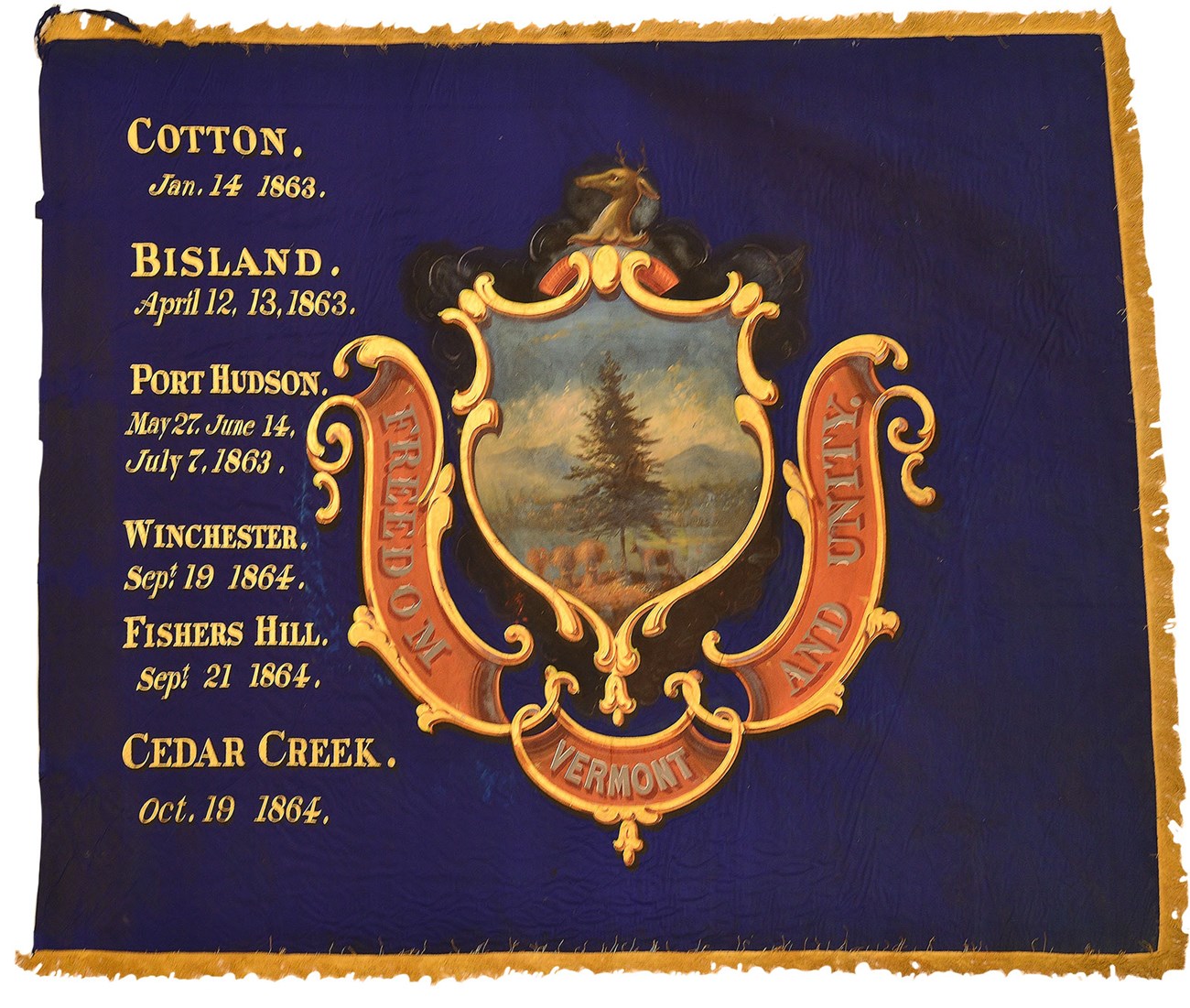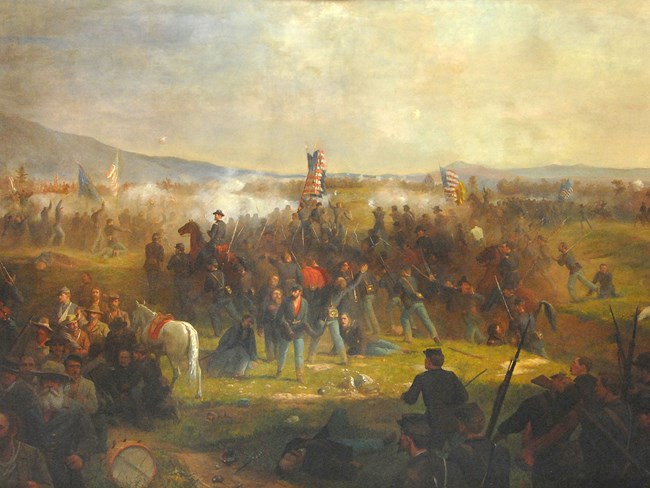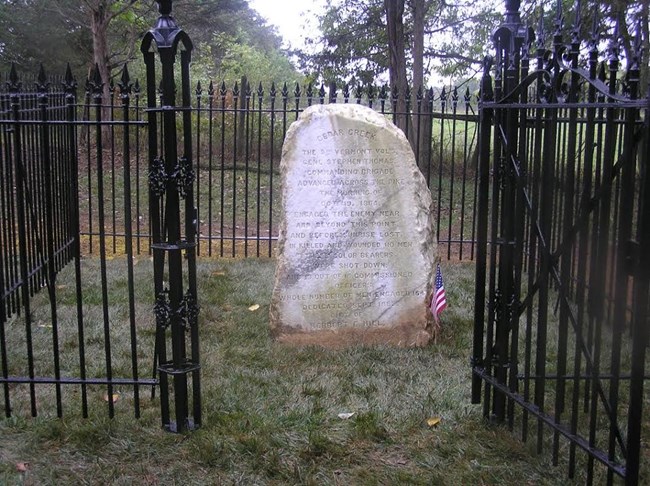Part of a series of articles titled A Victory Turned From Disaster.
Previous: Bearing the Brunt
Next: A Rich Prize
Article

Carpenter's History of the 8th Vermont Regiment
5:45 a.m.—In a desperate attempt to stem the onward rush of Confederates, Col. Stephen Thomas was ordered to sacrifice his 1,000 soldiers from Vermont, New York, Connecticut, and Pennsylvania. The fight that followed was a “vortex of hell,” one veteran later claimed. In the smoke and fog it quickly became a hand-to-hand fight. Rifles became clubs, bayonets were used, both sides contested for control. The fighting was fiercest around the flags of the Eighth Vermont, but they were not taken. The regiment lost 110 of 164 men, but Thomas’ command had stalled the Confederate onslaught for 30 minutes. The monument marks the center of the regiment’s line, and also where three color bearers were killed defending their flags.

Vermont State Curator's Office
Organized and mustered in as a two-year regiment on February 18, 1862, the 8th Vermont went to the Department of the Gulf in Louisiana, where it guarded railroads and performed other duties. Assigned to the 19th Corps in January 1863, it saw service during the Red River Campaign in May, the siege of Port Hudson from May to July, and the Sabine Pass Expedition in September. When its enlistment expired in early 1864, it was designated a “veteran volunteer” regiment after enough men re-enlisted. It went north in July, along with the rest of the 19th Corps, to Washington, D.C., and then on to the Shenandoah Valley, where it participated in the battles of Third Winchester on September 19 and Fisher’s Hill on September 22.
On the morning of October 19, Gen. Emory chose Colonel Stephen Thomas’s brigade, consisting of 4 regiments, to advance across the Valley Pike and hold the enemy in check while the 6th and 19th corps formed up. To the right of the 8th Vermont was the 160th New York, 12th Connecticut, and 47th Pennsylvania. The 8th Vermont, with 164 officers and men, faced parts of Gen. John B. Gordon’s division that included regiments from Louisiana, Virginia, and North Carolina.
Like other regiments, the 8th Vermont carried both the national and state flags into battle. “Color bearers” laid down their lives to maintain possession of the flag. These banners played an important role in battle as they helped to maintain regimental organization and became a beacon soldiers rallied around during the thickest of combat.

Vermont State Curator's Office
Once the 8th Vermont reached their position, they immediately formed into a battle line. Where the monument stands now marks the spot where the color-bearers, those soldiers responsible for carrying the national and state flags, stood. The sounds of battle increased, and one Vermonter remembered:
“In an instant the timber was a blaze of light from musketry, and we were in the midst of one of the most fearful struggles of the war.”
“Suddenly a mass of rebels confronted the flags, and with hoarse shouts demanded their surrender." Defiant shouts went back, “Never!” “Never!” Another member of the regiment described the scene:
“the enemy, with deafening yells, were moving swiftly in from front and flank... Yet the sudden rush of the enemy from every direction, in their yellowish suits, breaking through even the short intervals between the commands, forced each regiment to fight its own battle; and so the Eighth Vermont was practically alone for a time, - and who can county such moments? – as the swarming enemy broke upon it with almost resistless fury.”
Striking them suddenly was part of Gen. John B. Gordon’s Confederate division. The heavy fog not only made visibility nearly impossible, but the Confederate uniforms of grays and browns blended with the color of the mist, while the dark blue uniforms of the Union soldiers stood out. Just as bad was the collapse of the Union forces to the left. Thomas had been sent to support those troops, but Col. Rutherford B.Hayes’s division and Howard Kitching’s “Provisional Division” were now in full retreat.
Thus, Thomas’s men found themselves being attacked from three sides: left, front and right. The fight became
“…one of the most desperate and ugly hand-to-hand conflicts over the flags that has ever been recorded… Men seemed more like demons than human beings, as they struck fiercely at each other with clubbed musket and bayonet.”
Finally, with the 8th Vermont “bleeding, stunned and literally cut to pieces,” Thomas ordered what was left of the regiment to fall back. During this struggle three color bearers were killed, but ultimately the flags were saved. Sergeant Moran, who held the national colors, was not touched.
Thomas’ brigade was decimated. Out of the 1,500 officers and men who went into the fight, it lost approximately 1,060, or over 70 percent. The 8th Vermont lost 110 killed, wounded, and captured out of 164, or 68 percent. The sacrifice had not been in vain. Their desperate holding action delayed the Confederate attack nearly 30 minutes. The Federals at Belle Grove used these precious minutes to prepare for the Confederate attack coming their way.

NPS
Sheridan’s veterans returned to the Valley in 1883 and 1885. In 1883 Gen. William Emory, commander of the 19th Corps, took Col. Thomas by the hand and said with much feeling, “Thomas, I never gave an order in my life that cost me so much pain as it did to order you across the pike that morning. I never expected to see you again.”
Herbert Hill was 16 when he enlisted in the 8th Vermont in 1862, and 18 when he fought at Cedar Creek. Hill honored his lost comrades, and the service of his entire regiment, by commissioning two monuments: one for the battlefield at Third Winchester and other for Cedar Creek. Dedicated in 1885, the monument marks where the three color bearers were killed defending their flags. Hill's fellow veteran said of the monument’s meaning:
“It is but fitting that we… should make pilgrimages to this spot, made sacred by the blood of our brothers in arms, and erect a monument in memory of that sublime courage that characterized the sacrifice of that terrible 19th of October, 1864.”
Part of a series of articles titled A Victory Turned From Disaster.
Previous: Bearing the Brunt
Next: A Rich Prize
Last updated: December 17, 2021